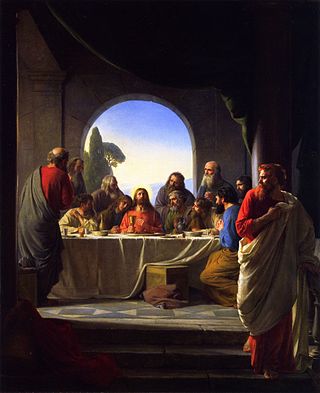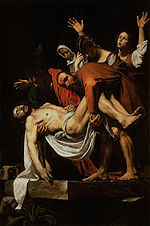
Gnosticism is a collection of religious ideas and systems that coalesced in the late 1st century AD among Jewish and early Christian sects. These various groups emphasized personal spiritual knowledge (gnosis) above the proto-orthodox teachings, traditions, and authority of religious institutions. Gnostic cosmogony generally presents a distinction between a supreme, hidden God and a malevolent lesser divinity who is responsible for creating the material universe. Consequently, Gnostics considered material existence flawed or evil, and held the principal element of salvation to be direct knowledge of the hidden divinity, attained via mystical or esoteric insight. Many Gnostic texts deal not in concepts of sin and repentance, but with illusion and enlightenment.

The Gospel of Barnabas is a non-canonical, pseudepigraphical gospel written in the Late Middle Ages and attributed to the early Christian disciple Barnabas, who is one of the apostles of Jesus. It is about the same length as the four canonical gospels combined and largely harmonises stories in the canonical gospels with Islamic elements such as the denial of Jesus' crucifixion. The gospel presents a detailed account of the life of Jesus. It begins with the nativity of Jesus, which includes the annunciation by the archangel Gabriel to Mary which precedes Jesus' birth. The gospel follows his ministry, ending with the message of Jesus to spread his teachings around the world. Judas Iscariot replaced Jesus at the crucifixion.

Judas Iscariot was—according to Christianity's four canonical gospels—a disciple and one of the original Twelve Apostles of Jesus Christ. Judas betrayed Jesus to the Sanhedrin in the Garden of Gethsemane by kissing him on the cheek and addressing him as "master" to reveal his identity in the darkness to the crowd who had come to arrest him. Like Brutus, his name is often used synonymously with betrayal or treason.

The Gospel of Thomas is an extra-canonical sayings gospel. It was discovered near Nag Hammadi, Egypt, in December 1945 among a group of books known as the Nag Hammadi library. Scholars speculate that the works were buried in response to a letter from Bishop Athanasius declaring a strict canon of Christian scripture. Scholars have proposed dates of composition as early as 60 AD and as late as 250 AD. Since its discovery, many scholars have seen it as evidence in support of the existence of a "Q source" which might have been very similar in its form as a collection of sayings of Jesus without any accounts of his deeds or his life and death, referred to as a sayings gospel.

The Nag Hammadi library is a collection of early Christian and Gnostic texts discovered near the Upper Egyptian town of Nag Hammadi in 1945.

Simon the Zealot or Simon the Canaanite or Simon the Canaanean was one of the most obscure among the apostles of Jesus. A few pseudepigraphical writings were connected to him, but Jerome does not include him in De viris illustribus written between 392 and 393 AD.

The Gospel of Philip is a non-canonical Gnostic Gospel dated to around the 3rd century but lost in medieval times until rediscovered by accident, buried with other texts near Nag Hammadi in Egypt, in 1945.

The New Testament apocrypha are a number of writings by early Christians that give accounts of Jesus and his teachings, the nature of God, or the teachings of his apostles and of their lives. Some of these writings were cited as scripture by early Christians, but since the fifth century a widespread consensus has emerged limiting the New Testament to the 27 books of the modern canon. Roman Catholic, Eastern Orthodox, and Protestant churches generally do not view the New Testament apocrypha as part of the Bible.

The Gospel of Judas is a non-canonical Gnostic gospel. The content consists of conversations between Jesus and Judas Iscariot. Given that it includes late 2nd-century theology, it is widely thought to have been composed in the 2nd century by Gnostic Christians, rather than the historic Judas himself. The only copy of it known to exist is a Coptic language text that has been carbon dated to 280 AD, plus or minus 60 years. It has been suggested that the text derives from an earlier manuscript in the Greek language. An English translation was first published in early 2006 by the National Geographic Society.
Apocryphon, plural apocrypha, was a Greek term for a genre of Jewish and Early Christian writings that were meant to impart "secret teachings" or gnosis (knowledge) that could not be publicly taught. Jesus briefly withheld his messianic identity from the public. Based on that fact, some hypothesize without support that he also gave private instruction to the apostles, figures in the canonical Gospels of the New Testament and furnishes the material of the "sayings" Gospel of Thomas and part of the material of the Gospel of Mary. It is purportedly a secret teaching supposedly committed to a trusted disciple by Christ after his resurrection. The secret teaching in Gnostic literature refers to several things.

The Book of the Resurrection of Jesus Christ, by Bartholomew the Apostle is a pseudonymous work of the New Testament apocrypha. It is not to be confused with the book called Questions of Bartholomew and either text may be the missing Gospel of Bartholomew, a lost work from the New Testament apocrypha. It is considered to have been written in the 8th or 9th century, although the exact date is uncertain.
The Sethians were one of the main currents of Gnosticism during the 2nd and 3rd century CE, along with Valentinianism and Basilideanism. According to John D. Turner, it originated in the 2nd century CE as a fusion of two distinct Hellenistic Judaic philosophies and was influenced by Christianity and Middle Platonism. However, the exact origin of Sethianism is not properly understood.

The Gospel of the Truth is one of the Gnostic texts from the New Testament apocrypha found in the Nag Hammadi codices ("NHC"). It exists in two Coptic translations, a Subakhmimic rendition surviving almost in full in the first Nag Hammadi codex and a Sahidic in fragments in the twelfth codex.
The biblical account of the crucifixion, death, and resurrection of Jesus (ʿĪsā) recorded in the Christian New Testament is traditionally rejected by the major branches of Islam, but like Christians they believe that Jesus ascended to heaven and he will, according to Islamic literary sources, return before the end of time. The various sects of Islam have different views regarding this topic; traditionally, mainstream Muslims believe that Jesus was not crucified but was bodily raised up to heaven by God, while Ahmadi Muslims reject this belief and instead contend that Jesus survived the crucifixion, was taken off the cross alive and continued to preach in India until his natural death.

The Gospel of Basilides is the title given to a reputed text within the New Testament apocrypha, which is reported in the middle of the 3rd century as then circulating amongst the followers of Basilides (Βασιλείδης), a leading theologian of Gnostic tendencies, who had taught in Alexandria in the second quarter of the 2nd century. Basilides's teachings were condemned as heretical by Irenaeus of Lyons, and by Hippolytus of Rome, although they had been evaluated more positively by Clement of Alexandria. There is, however, no agreement amongst Irenaeus, Hippolytus or Clement as to Basilides's specific theological opinions; while none of the three report a gospel in the name of Basilides.
April D. DeConick is the Isla Carroll and Percy E. Turner Professor of New Testament and Early Christianity at Rice University in Houston, Texas. She came to Rice University as a full professor in 2006, after receiving tenure at Illinois Wesleyan University in 2004. DeConick is the author of several books in the field of Early Christian Studies and is best known for her work on the Gospel of Thomas and ancient Gnosticism.
Stephen Emmel is a Coptologist and musician.
In Sethian Gnostic texts, the Five Seals are typically described as a baptismal rite involving a series of five full immersions in holy running or "living water," symbolizing spiritual ascension to the divine realm. The Five Seals are frequently mentioned in various Sethian Gnostic texts from the Nag Hammadi library.
The Book of the Cock is a Geʽez narrative of the passion of Jesus. It was likely written in the fifth or sixth centuries and is based on an earlier version in Arabic or Greek. It has contemporary use among some Ethiopian Christians.




